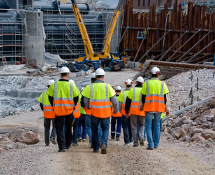Two workers were killed in Boston last Friday, October 21st, when a water main broke and flooded the 15-foot trench where they were working. When fire crews arrived on the scene they found “workers trapped in a trench in the ground that was filling rapidly with water” according to fire department spokesman Steve MacDonald. Boston Police Commissioner William B. Evans told The Boston Globe that it appears “somehow a pipe must have broke and unfortunately they weren’t able to get themselves out of a hole.” He said it appeared other workers were able to escape from the trench.
A response team spent hours vacuuming water and clearing the trench Friday afternoon. The Boston Fire Department described the operation as “very difficult” as the team worked in a trench box on their knees removing dirt by hand to recover the bodies. Boston Police, OSHA, and the Suffolk County District Attorney’s Office will be investigating the cause of the deadly incident, MacDonald said.
The workers were employed by Atlantic Drain Services, a family owned drain cleaning company with over $95,000 in outstanding OSHA violations and fines.
Excavating is recognized as one of the most hazardous construction operations. In addition to essential equipment, employee training and the clear understanding of safe practices are essential. Knowledge coupled with the proper tools help create a safety-minded workforce, mitigating your risk and lowering the potential for hazards.
OSHA’s updated guide on Trenching & Excavation Safety provides information on when employers must conduct site inspections, requirements for protective systems and PPE, and updated details on the means of egress employers must provide workers.
How can employers avoid hitting underground utility lines and pipes during excavation work? Before starting work, excavation standards require employers to do the following:
- Call 811, the “Call Before You Dig” number to establish the location of any underground utility installations in the work area.
- Ask the utility companies or owners to establish the location of underground installations prior to the start of excavation work.
- Contact and notify the utility companies or owners involved to inform them of the proposed work within the established or customary local response times.
- Determine the exact location of underground installations by safe and acceptable means when excavation operations approach the approximate location of the installations.
- Ensure that while the excavation is open, underground utilities are protected, supported or removed as necessary and approved by the utility owner. Be aware of all utility hazards.
For more information or to schedule training, feel free to contact The Integrated Group at 425-822-8500 of info@theintegratedgroup.com.






No comments yet.